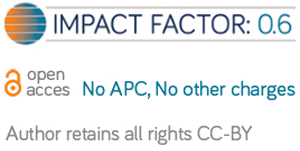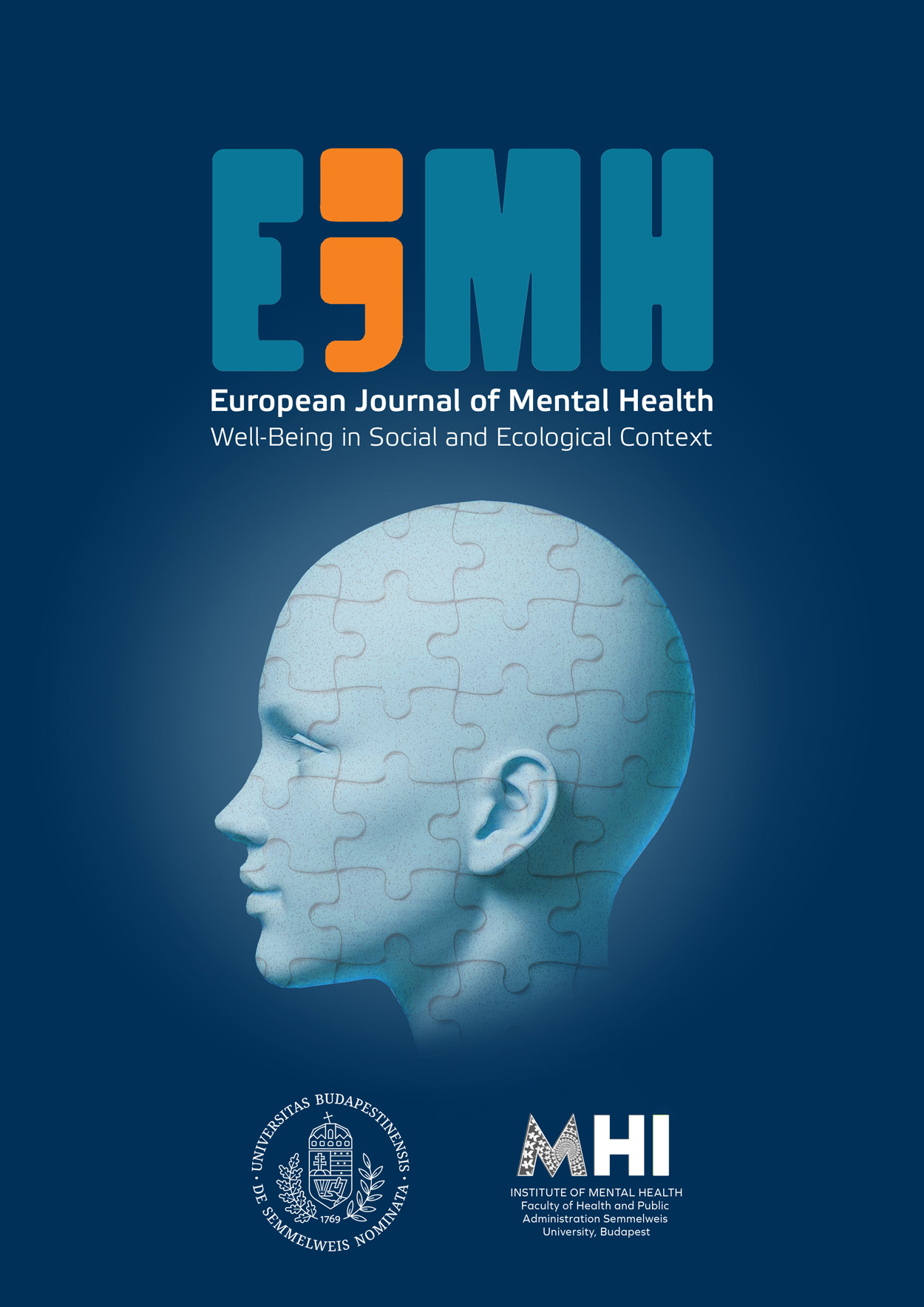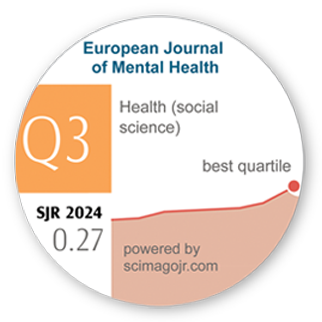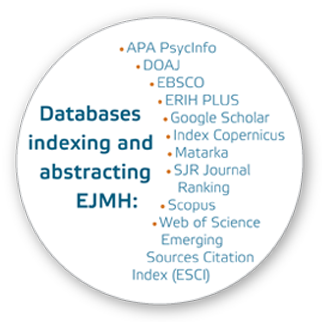Features of Polypharmacy in Dutch Older Outpatients with Personality Disorders: A Cross-sectional Study
DOI:
https://doi.org/10.5708/EJMH.19.2024.0016Keywords:
polypharmacy, pharmacotherapy, anticholinergic burden, personality disorders, geriatric psychiatryAbstract
Introduction: Pharmacotherapy in older adults with personality disorders (PDs) can be even more complicated compared to younger adults, because older adults stand at risk for polypharmacy and its negative consequences due to somatic comorbidities and biological age-related changes.
Aims: This study’s primary objective serves to describe the point prevalence of polypharmacy in older adults with PDs. Next, we described 1) the number of psychotropics employed, 2) classes of psychotropics, 3) the number of somatic medication, and 4) the anticholinergic burden of the total medication.
Methods: This cross sectional study was performed at a clinical center of excellence for older adults with PDs in the Netherlands. Fifty outpatients aged 65 years and older with a primary diagnosis of a PD were selected from an alphabetically ordered list. Data from the files on polypharmacy (use of five medications or more daily), use of medication and the anticholinergic burden (ARS score) was collected.
Results: Polypharmacy was present in 72% of older adults with PDs. The mean number of psychotropics was 2.0 (SD 1.4) psychotropics per person, for somatic medication the mean was 6.2 (SD 3.6). Antidepressants were the most frequently prescribed (used by 62%), followed by anxiolytics (used by 40%). The mean ARS score was 1.1 points (SD 1.7).
Conclusions: The prevalence of polypharmacy in older adults with PDs stands high, due to the high use of both psychotropics and somatic medication. Although this study provides important and new information on the use of medication in older adults, its representation of the population may be limited due to the tertiary care setting and small sample size excluding certain PDs (e.g., schizoid or obsessive-compulsive PD). Also, we did not register or measure the consequences of polypharmacy.
References
Allende-Alonso, S., Bouza-Herrera, C. N., Rizvi, S. E. H., & Sautto-Vallejo, J. M. (2019). Big data and the central limit theorem: A statistical legend. Revista Investigación Operacional, 40(1), 112–123.
https://revistas.uh.cu/invoperacional/article/view/2694
American Psychiatric Association. (1994). Diagnostic and statistical manual of mental disorders: DSM-IV (4th ed.).
American Psychiatric Association Practice Guidelines. (2001). Practice guideline for the treatment of patients with borderline personality disorder. American Psychiatric Association. American Journal of Psychiatry, 158(10 Suppl), 1–52.
Beers, M. H. (1997). Explicit criteria for determining potentially inappropriate medication use by the elderly. An update. Archives of Internal Medicine, 157(14), 1531–1536.
Bender, D. S., Dolan, R. T., Skodol, A. E., Sanislow, C. A., Dyck, I. R., McGlashan, T. H., Shea, M. T., Zanarini, M. C., Oldham, J. M., & Gunderson, J. G. (2001). Treatment utilization by patients with personality disorders. American Journal of Psychiatry, 158(2), 295–302.
https://doi.org/10.1176/appi.ajp.158.2.295
Bourgeois, F. T., Shannon, M. W., Valim, C., & Mandl, K. D. (2010). Adverse drug events in the outpatient setting: An 11-year national analysis. Pharmacoepidemiol Drug Saf, 19(9), 901–910.
https://doi.org/10.1002/pds.1984
Charlesworth, C. J., Smit, E., Lee, D. S. H., Alramadhan, F., & Odden, M. C. (2015). Polypharmacy among adults aged 65 years and older in the United States: 1988–2010. The Journal of Gerontology. Series A, 70(8), 989–995.
https://doi.org/10.1093/gerona/glv013
Dijk, C., Verheij, R. A., & Schellevis, F. G. (2009). Polyfarmacie bij ouderen [Polypharmacy in older adults]. Huisarts en Wetenschap, 52, 315–315.
https://doi.org/10.1007/BF03085663
Doan, J., Zakrzewski-Jakubiak, H., Roy, J., Turgeon, J., & Tannenbaum, C. (2013). Prevalence and risk of potential cytochrome P450-mediated drug-drug interactions in older hospitalized patients with polypharmacy. Annals of Pharmacotherapy, 47(3), 324–332.
https://doi.org/10.1345/aph.1R621
Fox, C., Smith, T., Maidment, I., Chan, W.-Y., Bua, N., Myint, P. K., Boustani, M., Kwok, C. S., Glover, M., Koopmans, I., & Campbell, N. (2014). Effect of medications with anti-cholinergic properties on cognitive function, delirium, physical function and mortality: A systematic review. Age and Ageing, 43(5), 604–615.
https://doi.org/10.1093/ageing/afu096
Frankenburg, F. R., & Zanarini, M. C. (2004). The association between borderline personality disorder and chronic medical illnesses, poor health-related lifestyle choices, and costly forms of health care utilization. The Journal of Clinical Psychiatry, 65(12), 1660–1665.
https://doi.org/10.4088/jcp.v65n1211
Fried, T. R., O’Leary, J., Towle, V., Goldstein, M. K., Trentalange, M., & Martin, D. K. (2014). Health outcomes associated with polypharmacy in community-dwelling older adults: A systematic review. Journal of American Geriatrics Society, 62(12), 2261–2272.
https://doi.org/10.1111/jgs.13153
Gutiérrez-Valencia, M., Izquierdo, M., Cesari, M., Casas-Herrero, Á., Inzitari, M., & Martínez-Velilla, N. (2018). The relationship between frailty and polypharmacy in older people: A systematic review. British Journal of Clinical Pharmacology, 84(7), 1432–1444.
https://doi.org/10.1111/bcp.13590
Holt, S., Schmiedl, S. & Thürmann, P. A. (2010). Potenziell inadäquate Medikation für ältere Menschen: Die PRISCUS-Liste [Potentially inappropriate medications in the elderly. The PRICUS list]. Deutsches Ärzteblatt International, 107(31–32), 543–551.
https://doi.org/10.3238/arztebl.2010.0543
Jun, K., Ah, Y. M., Hwang, S., Chung, J. E., & Lee, J. Y. (2020). Prevalence of anticholinergic burden and risk factors amongst the older population: Analysis of insurance claims data of Korean patients. Internation Journal of Clinical Pharmacy, 42(2), 453–461.
https://doi.org/10.1007/s11096-020-01010-7
Jyrkkä, J., Enlund, H., Lavikainen, P., Sulkava, R., & Hartikainen, S. (2011). Association of polypharmacy with nutritional status, functional ability and cognitive capacity over a three-year period in an elderly population. Pharmacoepidemiol Drug Saf, 20(5), 514–522.
https://doi.org/10.1002/pds.2116
Kann, I. C., Lundqvist, C., & Lurås, H. (2015). Polypharmacy among the elderly in a list-patient system. Drugs Real World Outcomes, 2(3), 193–198.
https://doi.org/10.1007/s40801-015-0036-3
Kratz, T., & Diefenbacher, A. (2019). Psychopharmacological treatment in older people: Avoiding drug interactions and polypharmacy. Deutsches Ärzteblatt International, 116, 508–518.
https://doi.org/10.3238/arztebl.2019.0508
Lampela, P., Lavikainen, P., Garcia-Horsman, J. A., Bell, J. S., Huupponen, R., & Hartikainen, S. (2013). Anticholinergic drug use, serum anticholinergic activity, and adverse drug events among older people: A population-based study. Drugs & Aging, 30, 321–330.
https://doi.org/10.1007/s40266-013-0063-2
Leelakanok, N., Holcombe, A. L., Lund, B. C., Gu, X., & Schweizer, M. L. (2017). Association between polypharmacy and death: A systematic review and meta-analysis. Journal of the American Pharmacists Association, 57(6), 729–738.e10.
https://doi.org/10.1016/j.japh.2017.06.002
Lemmens, L. C., & Weda, M. (2015). Polyfarmacie bij kwetsbare ouderen: Risico's rondom overgangen tussen eerste - en tweedelijnszorg [Polypharmacy in frail elderly: Risks during transition between primary care and secondary care]. Rijksinstituut voor Volksgezondheid en Milieu.
https://www.rivm.nl/bibliotheek/rapporten/2015-0088.pdf
Maggiore, R. J., Gross, C. P., & Hurria, A. (2010). Polypharmacy in older adults with cancer. The Oncologist, 15(5), 507–522.
https://doi.org/10.1634/theoncologist.2009-0290
Mann, N. K., Mathes, T., Sönnichsen, A., Pieper, D., Klager, E., Moussa, M., & Thürmann, P. A. (2023). Potentially inadequate medications in the elderly: PRISCUS 2.0. Deutsches Ärzteblatt International, 120, 3–10.
https://doi.org/10.3238/arztebl.m2022.0377
Masnoon, N., Shakib, S., Kalisch-Ellett, L., & Caughey, G. E. (2017). What is polypharmacy? A systematic review of definitions. BMC Geriatrics, 17, Article 230.
https://doi.org/10.1186/s12877-017-0621-2
Mate, K. E., Kerr, K. P., Pond, D., Williams, E. J., Marley, J., Disler, P., Brodaty, H., & Magin, P. J. (2015). Impact of multiple low-level anticholinergic medications on anticholinergic load of community-dwelling elderly with and without dementia. Drugs & Aging, 32, 159–167.
https://doi.org/10.1007/s40266-014-0230-0
Mojtabai, R., & Olfson, M. (2010). National trends in psychotropic medication polypharmacy in office-based psychiatry. Archives of Geneneral Psychiatry, 67(1), 26–36.
https://doi.org/10.1001/archgenpsychiatry.2009.175
Montiel-Luque, A., Núñez-Montenegro, A. J., Martín-Aurioles, E., Canca-Sánchez, J. C., Toro-Toro, M. C., González-Correa, J. A., & the members of Polipresact Research Group. (2017). Medication-related factors associated with health-related quality of life in patients older than 65 years with polypharmacy. PLoS One, 12(2), Article e0171320.
https://doi.org/10.1371/journal.pone.0171320
Nishtala, P. S., & Salahudeen, M. S. (2015). Temporal trends in polypharmacy and hyperpolypharmacy in older New Zealanders over a 9-year period: 2005–2013. Gerontology, 61(3), 195–202.
https://doi.org/10.1159/000368191
Park, H.-Y., Park, J.-W., Song, H. J., Sohn, H. S., & Kwon, J.-W. (2017). The association between polypharmacy and dementia: A nested case-control study based on a 12-year longitudinal cohort database in South Korea. PLoS One, 12(1), Article e0169463.
https://doi.org/10.1371/journal.pone.0169463
Pasina, L., Djade, C. D., Lucca, U., Nobili, A., Tettamanti, M., Franchi, C., Salerno, F., Corrao, S., Marengoni, A., Iorio, A., Marcucci, M., Violi, F., & Mannuci, P. M. (2013). Association of anticholinergic burden with cognitive and functional status in a cohort of hospitalized elderly: Comparison of the anticholinergic cognitive burden scale and anticholinergic risk scale. Results from the REPOSI study. Drugs & Aging, 30, 103–112.
https://doi.org/10.1007/s40266-012-0044-x
Penders, K. A. P., Peeters, I. G. P., Metsemakers, J. F. M., & van Alphen, S. P. J. (2020). Personality disorders in older adults: A review of epidemiology, assessment, and treatment. Current Psychiatry Reports, 22, Article 14.
https://doi.org/10.1007/s11920-020-1133-x
Rudolph, J. L., Salow, M. J., Angelini, M. C., & McGlinchey, R. E. (2008). The anticholinergic risk scale and anticholinergic adverse effects in older persons. Archives of Internal Medicine, 168(5), 508–513.
https://doi.org/10.1001/archinternmed.2007.106
Sarkar, S. (2017). Psychiatric polypharmacy, etiology and potential consequences. Current Psychopharmacology, 6(1), 12–26.
https://doi.org/10.2174/2211556005666160916124719
Schulkens, J., Bergs, N., Ingenhoven, T., Rosowsky, E., van Alphen, S., & Sobczak, S. (2021). Selective serotonin reuptake-inhibitors for symptom-based treatment of borderline personality disorders in older adults: An international Delphi study. Clinical Psychopharmacology and Neuroscience, 19(1), 53–62.
https://doi.org/10.9758/cpn.2021.19.1.53
Slabaugh, S. L., Maio, V., Templin, M., & Abouzaid, S. (2010). Prevalence and risk of polypharmacy among the elderly in an outpatient setting: A retrospective cohort study in the Emilia-Romagna region, Italy. Drugs & Aging, 27, 1019–1028.
https://doi.org/10.2165/11584990-000000000-00000
Spitzer, R. L. (1983). Psychiatric diagnosis: Are clinicians still necessary? Comprehensive Psychiatry, 24(5), 399–411.
https://doi.org/10.1016/0010-440x(83)90032-9
Stuhec, M., & Lah, L. (2021). Clinical pharmacist interventions in elderly patients with mental disorders in primary care focused on psychotropics: A retrospective pre-post observational study. Therapeutic Advences in Psychopharmacology, 11.
https://doi.org/10.1177/20451253211011007
Taylor, A. W., Price, K., Gill, T. K., Adams, R., Pilkington, R., Carrangis, N., Shi, Z., & Wilson, D. (2010). Multimorbidity - not just an older person’s issue. Results from an Australian biomedical study. BMC Public Health, 10, Article 718.
https://doi.org/10.1186/1471-2458-10-718
Tian, F., Chen, Z., & Wu, J. (2022). Prevalence of polypharmacy and potentially inappropriate medications use in elderly chinese patients: A systematic review and meta-analysis. Frontiers in Pharmacology, 13, Article 862561.
https://doi.org/10.3389/fphar.2022.862561
Tune, L. E. (2001). Anticholinergic effects of medication in elderly patients. The Journal of Clinical Psychiatry, 62 Suppl 21, 11–14.
https://pubmed.ncbi.nlm.nih.gov/11584981/
van den Brink, A. M. A., Gerritsen, D. L., de Valk, M. M. H., Oude Voshaar, R. C., & Koopmans, R. T. C. M. (2017). Characteristics and health conditions of a group of nursing home patients with mental-physical multimorbidity - the MAPPING study. International Psychogeriatrics, 29(6), 1037–1047.
https://doi.org/10.1017/s1041610217000230
Verheul, R., & Widiger, T. A. (2004). A meta-analysis of the prevalence and usage of the personality disorder not otherwise specified (PDNOS) diagnosis. Journal of Personality Disorders, 18(4), 309–319.
https://doi.org/10.1521/pedi.18.4.309.40350
Wastesson, J. W., Fastbom, J., & Johnell, K. (2016). Expanding the proportion of life with polypharmacy in Sweden: 2006–2013. Journal of the American Medical Directors Association, 17(10), 957–958.
https://doi.org/10.1016/j.jamda.2016.07.006
Watanabe, S., Fukatsu, T., & Kanemoto, K. (2018). Risk of hospitalization associated with anticholinergic medication for patients with dementia. Psychogeriatrics, 18(1), 57–63.
https://doi.org/10.1111/psyg.12291
Zanarini, M. C., Frankenburg, F. R., Hennen, J., & Silk, K. R. (2004). Mental health service utilization by borderline personality disorder patients and Axis II comparison subjects followed prospectively for 6 years. The Journal of Clinical Psychiatry, 65(1), 28–36.
https://doi.org/10.4088/jcp.v65n0105






